Feeding horses
All animals need adequate nutrition to maintain health. Horses with poor pasture or little pasture will lose weight and body condition. Animal owners have a duty of care to provide adequate nutrition and clean drinking water. If your pasture can’t supply the required nutrition, horses will need to be supplemented or fully hand fed.
A horse’s body condition can be scored on the following scale:
- Poor
- Moderate
- Good
- Fat
- Very fat
Once a horse reaches a condition score of 2 - Moderate, it will need feeding to maintain health and return to an optimum condition of 3 - Good.
| Body condition score 1 – Poor | |
|---|---|
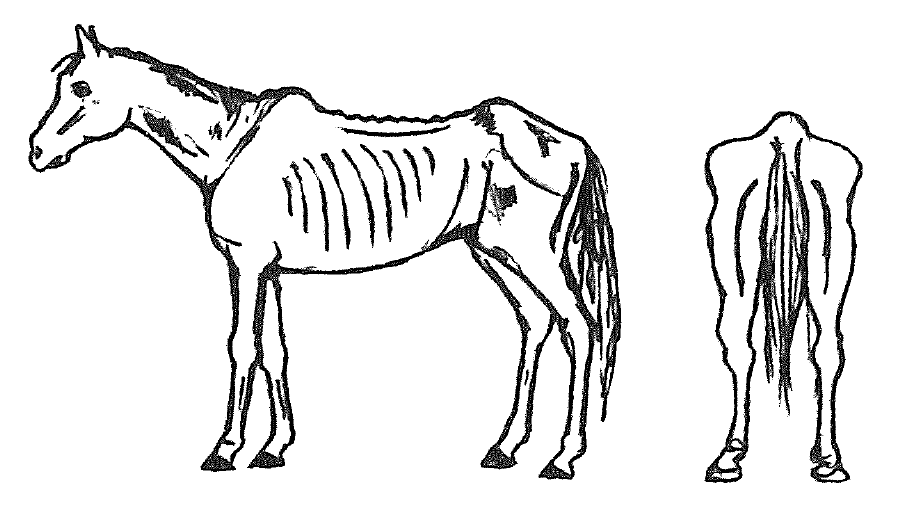 |
|
| Body condition score 2 – Moderate | |
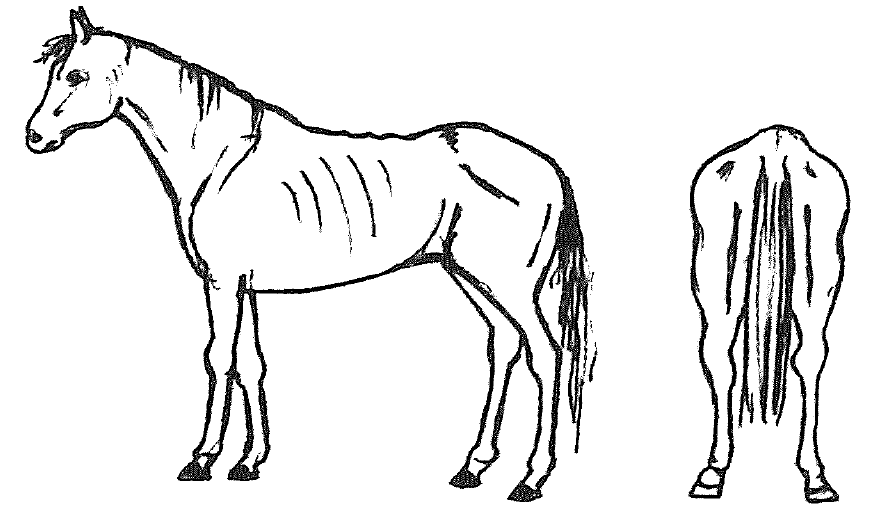 |
|
| Body condition score 3 – Good | |
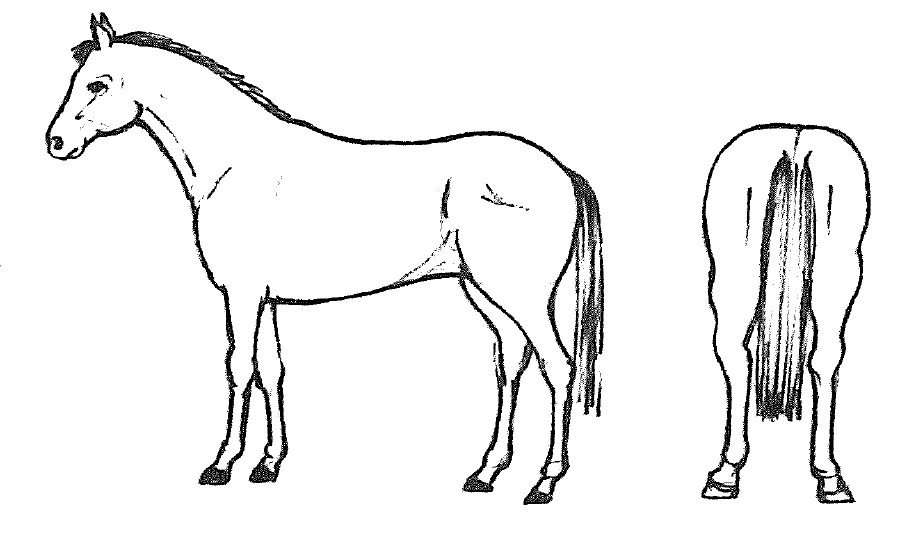 |
|
| Body condition score 4 – Fat | |
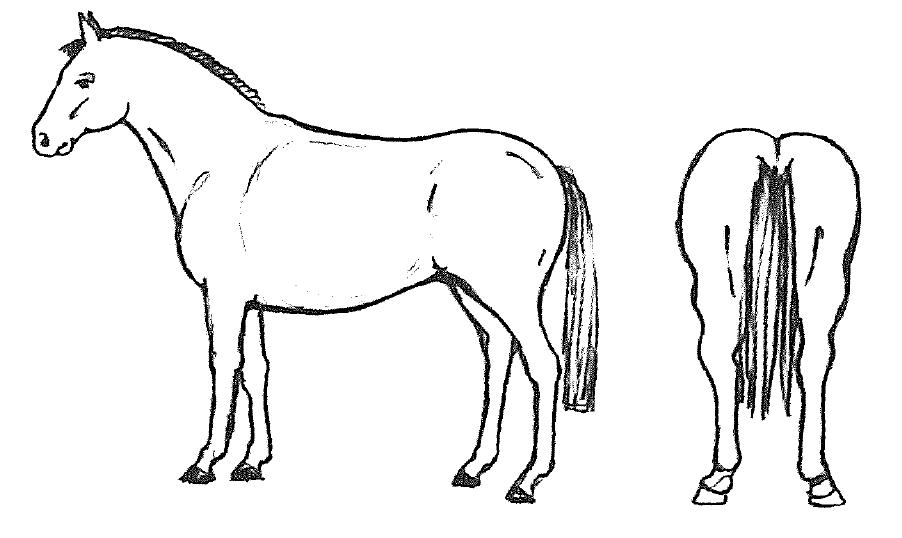 |
|
| Body condition score 5 – Very fat | |
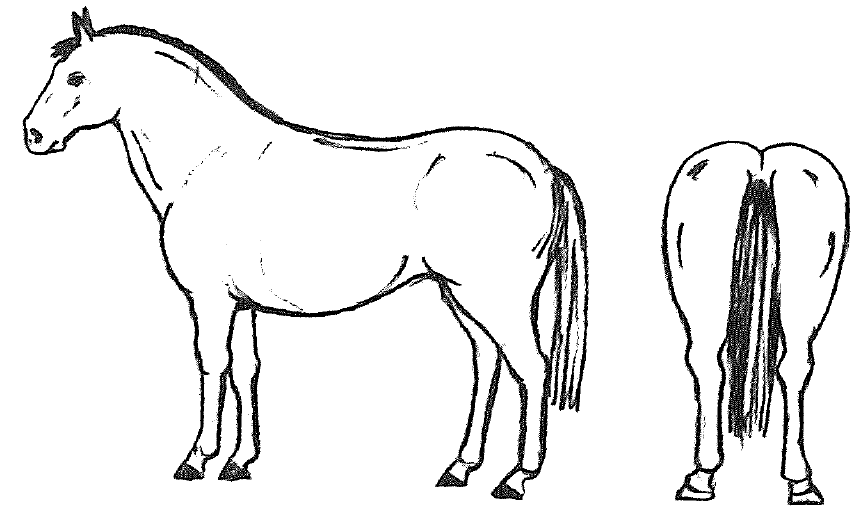 |
|
Source: Animal health and disease investigation: for stock inspectors and animal managers (1998)
Similar descriptors apply for other animal species as well. For example horse, sheep, goats, alpacas—palpate if excessive wool or hair impacts visual assessment.
Knowing your horse’s weight is a good guide to its dietary requirements for maintenance. The weight of a horse can be estimated by its height and body condition score.
Height | Condition score | |||||
|---|---|---|---|---|---|---|
Hands | cm | 1 | 2 | 3 | 4 | 5 |
12 | 120 | 190 | 210 | 250 | 300 | 360 |
13 | 130 | 240 | 285 | 345 | 375 | 455 |
14 | 140 | 310 | 330 | 400 | 460 | 540 |
15 | 150 | 380 | 420 | 465 | 535 | 600 |
16 | 160 | 420 | 470 | 520 | 575 | 650 |
Source: Estimating a horse’s condition and weight (2009)
-
Feed quality
Generally the best options for feeding horses for maintenance is a good quality hay. If hay quality is lower, a grain or pellet supplement may be used. Roughage for horses should be at least 50% of the ration if a mix is used. The quality of hay varies widely. The energy in feed is measured in megajoules per kilogram (MJ/kg). Quality is also affected by protein levels of the feed. Cane tops can vary greatly in quality and are not recommended as a horse feed.
Feed type
Energy (MJ/kg)
Crude protein (%)
Oats
10
6–12
Horse pellets
10
8–20
Grass hay
6
5–10
Lucerne
8.5
16–25
Oaten hay
7
5–10
Straw (barley, wheat, oats)
5
3–5
Cane tops
5
5
Adapted from Nash d. 1999 et al.
-
How much to feed for maintenance only
Horses eat between 1.75 to 3% of their bodyweight each day, e.g. depending on its size, whether it is still growing, in foal or has a foal at foot.
A horse will generally eat about 2.5% of its bodyweight each day for maintenance. A horse in work will have higher dietary requirements. For maintenance a horse will need:
Weight (kg)
Feed requirements (kg) dry matter
MJ energy
400
10.0
56.1
500
12.5
68.6
600
15.0
81.2
Cost for full feeding a horse for 30 days
Feed prices current at 17 January 2020Horse weight and the amount of hay they need
Grass hay
$700/tLucerne
$900/tOaten hay
$500/tStraw
$350/tPellets 50% and straw 50%
$1000/t and $350/t400 kg
10 kg/day + 10% = 11 kg
$231
$297
$165
NA
$222
500 kg
12.5 kg/day + 10% = 13.75 kg
$288
$371
$206
NA
$253
600 kg
15 kg/day + 10% = 16.5 kg
$346
$445
$247
NA
$303
NA = straw fed as a full diet will not provide enough nutrition
For example, if you have a 500 kg horse in a paddock with no pasture, it will need to eat roughly 12.5 kg of hay every day. If you have lucerne bales that weight 25 kg and cost $30, you will need to feed the horse half a bale a day. Fifteen bales a month at $30 will cost $450.
Water
A horse will drink between 25 to 50 litres of water a day depending on temperature and the moisture content of the feed. If horses become dehydrated, they are more susceptible to developing colic. The water needs to be of good potable quality. Shade should be available.
-
Other things to consider when feeding horses
- It is better to start feeding horses while there is still some pasture in the paddock.
- Horses have a single stomach and cannot digest the lower quality feed that cattle and sheep can eat.
- Make changes to a horse’s diet gradually over 5 to 7 days.
- Talk to a veterinarian before attempting to supplement with any unusual foodstuffs.
- Feed horses in poor and very poor body condition on just good quality hay for at least the first two weeks. Ideally, split into smaller feeds throughout the day. For more information read the ‘How to feed starved horses’ fact sheet.
- Consider the feed requirements of all animals if group feeding, e.g. ponies versus large horses.
- Old horses may need special, additional feeding (often due to teeth) to maintain condition.
- Horses of any age with teeth problems may struggle to eat enough.
- Competition between horses for feed – horses need adequate feeding space or to be separated at feeding time to avoid injuries.
- Hungry horses will eat things they normally wouldn’t, e.g. poisonous plants.
- Slow feeder hay nets can help reduce feed waste.
- Overall horse health.
Water
A horse will drink between 25 to 50 litres of water a day depending on temperature and the moisture content of the feed. If horses become dehydrated, they are more susceptible to developing colic. The water needs to be of good potable quality and shade should be available.
Forecasting pasture
In the subtropics, summer rainfall largely determines how much pasture grows before the end of the pasture growing season, in autumn. Higher or lower summer rainfall gives higher or lower pasture yield for carrying stock for the year ahead. For most graziers, the paddock feed and water supplies available in April or May have to last until next summer. Many graziers comment on the benefits of moving early in the year to adjust stock numbers according to pasture supply.
Generally the aim is to let stock eat about 30% of the useful feed which is available at the end of the summer growing season (or 15–20% in low rainfall environments).
For example, if there is 3,000kg dry matter per hectare (ha) of useful pasture, then 30% x 3,000kg = 900kg of useful feed per hectare. If a cow eats around 9kg of dry matter a day, then there is about:
- 100 days grazing per 1ha
- 200 days grazing per 2ha
- 365 days grazing per 3.65ha.
It is ideal to do these dry season pasture budgets each autumn to adjust stock numbers according to pasture availability. Winter rain may grow some high moisture, high quality herbage but usually not a significant bulk of dry matter feed.
References:
Condition scoring and weight estimation of horses, Agriculture Victoria
Estimating a horse’s condition and weight, NSW Department of Primary Industry
Drought feeding and management for horses, Agriculture Victoria
Animal health and disease investigation: for stock inspectors and animal managers, Department of Agriculture and Fisheries (1998)